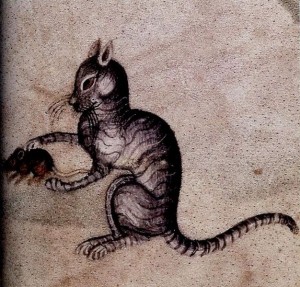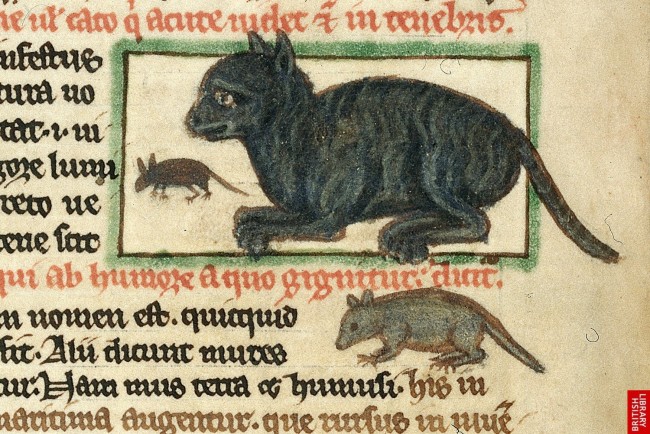Cats in medieval Europe mostly had a bad reputation – they were associated with witches and heretics, and it was believed that the devil could transform himself into a black cat. In her article, “Heretical Cats: Animal Symbolism in Religious Discourse,” Irina Metzler looks at how this view of felines emerged.
Cats filled one very important role for humans in the Middle Ages – they caught mice, which would have otherwise been a serious nuisance for people and their food. However, medieval writers even saw this activity in negative tones, often comparing the way cats caught mice with how the devil could catch souls. For example, William Caxton wrote “the devyl playeth ofte with the synnar, lyke as the catte doth with the mous.”
By the twelfth-century this association with the devil became even more ingrained. Around 1180, Walter Map explained in one of his works that during satanic rituals “the Devil descends as a black cat before his devotees. The worshippers put out the light and draw near to the place where they saw their master. They feel after him and when they have found him they kiss him under the tail.”
Heretical religious groups, such as the Cathars and Waldensians, were accused by Catholic churchmen of associating and even worshipping cats. When the Templars were put on trial in the early fourteenth-century, one of the accusations against them was allowing cats to be part of the services and even praying to the cats. Witches too, were said to be able to shape-shift into cats, which led to Pope Innocent VIII declaring in 1484 that “the cat was the devil’s favourite animal and idol of all witches.”
 Metzler believes that the independent nature of cats was the source of this anxiety from humans. Medieval people generally believed that animals were created by God to serve and be ruled by humans, but the cat, even when domesticated, cannot be trained to be loyal and obedient like a dog. Edward, Duke of York, writing in the early fifteenth-century, summed up what many medieval people must have thought: “their falseness and malice are well known. But one thing I dare well say that if any beast has the devil’s spirit in him without doubt it is the cat, both the wild and the tame.”
Metzler believes that the independent nature of cats was the source of this anxiety from humans. Medieval people generally believed that animals were created by God to serve and be ruled by humans, but the cat, even when domesticated, cannot be trained to be loyal and obedient like a dog. Edward, Duke of York, writing in the early fifteenth-century, summed up what many medieval people must have thought: “their falseness and malice are well known. But one thing I dare well say that if any beast has the devil’s spirit in him without doubt it is the cat, both the wild and the tame.”
Metzer writes:
Medieval people may have wanted to restrict cats to the function of animated mousetraps, for the very reason that the cat “stands at the threshold between the familiar and the wild.” “Cats were intruders into human society. They could not be owned. They entered the house by stealth, like mice, and were suffered because they kept the insufferable mice in check.” This causes a kind of conceptual tension. While the cat possesses the characteristics of a good hunter it is useful, “but as long as it does it remains incompletely domesticated.” Heretics, too, in a transferred sense, are not completely domesticated, since by challenging orthodox thought and roaming freely hither and thither in their interpretation of religious beliefs they resemble the bestiary definition of wildness. As symbolic animals,them, cats may be the heretical animal par excellence.
Not all medieval Europeans hated cats. There are many accounts of cats being kept as pets, including by nuns. Moreover, medieval Muslims were very fond of cats. A few accounts from early Islam suggest that the Prophet Muhammad and other figures liked cats and treated them well. Perhaps the cleanliness of cats was highly appealing to Muslims. In medieval Middle Eastern cities you could even find charities that took care of streets cats. One European pilgrim who traveled to the Middle East even noted that among the differences between Muslims and Christians was that “They like cats, while we like dogs.”
Metzer’s article, “Heretical Cats: Animal Symbolism in Religious Discourse,” appears in Medium Aevum Quotidianum Vol. 59 (2009). Irina Metzler teaches at Swansea University. You can find her personal website here.















Pentru a putea adăuga comentarii trebuie să fii membru al altmarius !
Alătură-te reţelei altmarius